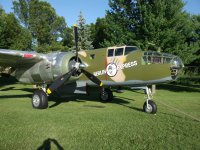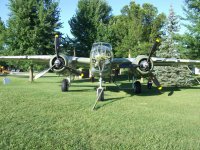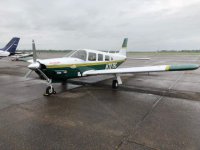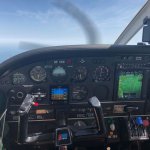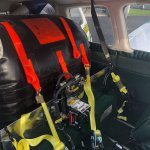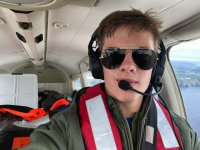"Louisiana teen brings home 3 world aviation records"
Well darned if he didn't do it, and apparently set three new world records in the process!
See this from the Monroe, LA News Star, October 6, 2018:
(click →)
"Louisiana teen brings home 3 world aviation records".
The actual route of flight is shown in this (click →)
Great Circle Map. Not all points shown were stops, I have added some (primarily between Karachi and Rayong) to more correctly show the route flown.
This solo round-the-world flight took 76 days vs. the originally expected 38-40 days, but with some "interesting" weather along the way: Thirty-three days from August 7 at Dubai World Central International Airport to September 19 at Naha, Okinawa, with delays due to the lousy flying weather in the southeast Asian monsoon and then THREE typhoons (Jebi, Mankhut and Trami) — the latter from the Philippines right up the spine of the Japanese islands, Kyushu, Shikoku, Honshu and Hokkaido. Then even still more lousy weather on September 24/25 from Naha to Yuzhno-Sakhalinsk, 49 days in all, just for this portion of the trip, for ≈ 6400 nm.
Yuzhno-Sakhalinsk? Yes! Mason Andrews wisely abandoned his original plan to fly 2,124 nm. non-stop from Sapporo, Japan to Dutch Harbor, Alaska(!) and instead flew from Naha, Okinawa via stops in
Russia(!)[SUP]1[/SUP] at both Yuzhno-Sakhalinsk and Magadan, then on to Nome, Alaska, for a far shorter leg over the Bering Sea.
After dealing with such lousy weather on the earlier legs of the flight, Yuzhno-Sakhalinsk to Magadan appeared to be in the clearest possible flying weather, “textbook CAVU” — in Russian airspace, no less! (With just a few clouds at 4000 ft. over the northern portion of the Sea of Okhotsk, approaching Magadan.) for ≈ 900 nm. in 6H + 24M. That and
NO OTHER AIR TRAFFIC — nary a single plane — other than some of the trans-polar flights like the B777-322ER from Newark (EWR) to Tokyo (NRT) that was overhead, flying N-S along Sakhalin Island at ≈34,000 ft.
Then Magadan to Nome[SUP]2[/SUP] (1,235 nm) was quite a different experience than the prior leg’s ≈ 900 nm. in nearly perfect CAVU conditions. But once again,
NO OTHER AIR TRAFFIC — nary a single plane — other than some of the trans-polar flights at ≈ 35,000 ft.
Knowing how much fun it was dealing with three tropical storms/typhoons in East Asia, mother nature kindly interposed Hurricane Rosa from the Gulf of California well into Arizona and beyond, from Sunday September 30 - Wednesday October 4, inspiring yet another change of plans, bailing out on the planned California & Arizona legs of the trip and hightailing it from Nome, Alaska to Whitehorse, Yukon to Edmonton, Alberta to Casper, WY, to Roswell, NM to Dallas, to Shreveport to Monroe, LA instead.
Note[SUP]1[/SUP]: Mason Andrews must have had a real Crackerjack support team handling/coordinating diplomatic/political/administrative issues for this trip, particularly for the Russian segment; just obtaining a visa for such a trip used to take months.
My research turned up little current information about general aviation in Russia.
As recently as 2007 any foreign pilot was required to hire a Russian "navigator" (a.k.a KGB/FSB "minder") to tag along on each flight, ostensibly to help with the translation of air traffic control communications and the like. Furthermore, there was no 100LL avgas available at all in Eastern Russia/Siberia/Kamchatka, and an IAOPA group trip across Russia had to arrange to have 100LL avgas delivered by a cargo carrier — in barrels(!) to each of their enroute stops.
Note[SUP]2[/SUP]:
As for myself, a VFR pilot (instrument trained but no rating), as I was contemplating the leg from Magadan to Nome, all I saw was some ominous looking weather, quite a bit of clouds, rain, ICGICIP(!), low overcast, mountains obscured, etc. in the sparsely populated, inhospitable Kamchatka/Chukotka region and in the Bering Sea, and of course headwinds of 15-25 kt. or more. I would not have done it. And arriving at Nome 7 minutes before sunset?
I have logged many trips across the desert from DVT-LAX and vice versa at night, when there are more lights in the sky (but no Northern Lights!) than on the ground, so I do know something about that, but over the Bering Sea that close to sunset?

This young pilot has demonstrated some very sound judgement and professionalism on earlier legs of this trip. I wasn't going to question his judgement from 5000 miles distant.
